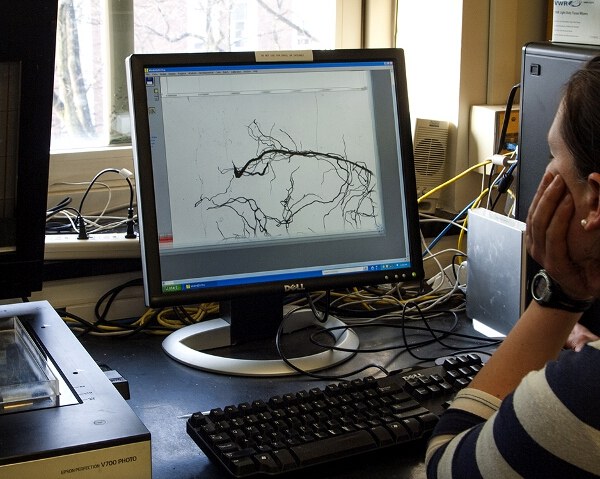The Roots Lab has access to laboratories totaling approximately 3,000 sq. ft. at the Penn State campus.

Students using Roots Lab equipment
Equipment includes facilities for digestion and elemental analysis of soil and plant samples and other routine chemical and biochemical analytical equipment such as a UV-vis spectrophotometer (PerkinElmer Lambda 25), atomic absorption spectrophotometer (PerkinElmer AAnalyst 100), and an Ion Chromatograph (Dionex ICS-1100) elemental analyszer (Perkin Elmer 2400 Series II CHN analyzer).

Greenhouse and in-field measurements of plant physiology can be done with a WP4 dewpoint potentiometer (Decagon Devices, Inc), balances, centrifuges, water baths, incubators, microcomputers, pH meters, automatic root washer, LI-COR 6252 IRGAs, LI-COR 6200 and 6400 portable photosynthesis systems, a Walz PAM-101 chlorophyll fluorometer, a Hansatech gas phase oxygen electrode system, a PTI Delta-scan dual wavelength scanning monochrometer-based epifluorescence microscope facility, radionuclide facilities including beta and gamma scintillation spectrometers, a low speed centrifuge and microcentrifuges, electrophoresis equipment, DNA thermal cycler, hybridization oven, temperature controlled water baths (shaking and still), incubators and a Hewlett Packard 6890 GC with FI and TC detectors.

For documentation and analysis, computer controlled gel and microscopy digital imaging systems are available, connected with zoom digital cameras, analysis software and Adobe Photoshop. Ultracentrifuges, scintillation counter, gel dryer, sterile transfer hood, autoclaves, -80°C and -20°C freezers, cold rooms and a dark room are available in the same building. Root analysis, acquisition of images of whole roots, and quantification of root area, length and diameter class stratification are possible with two WINRHIZO PRO stations (Regent Instruments), implemented on microcomputers with flatbed scanners. Soil water can be monitored with a TRIME TDR (Mesa Systems) in the field and a multiplexed TDR (Campbell Scientific) linked with a CR21X data logger (Campbell Scientific) both in the greenhouse and with a solar panel in the field.


